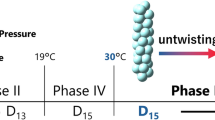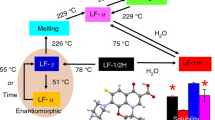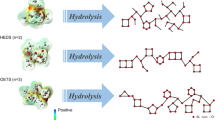Abstract
Piperazine is a saturated six-membered heterocyclic compound that is used for commercial CO2 removal for carbon capture and storage. In this work, we have investigated piperazine conformers' structure and orientation at an aqueous solution's surface using surface-specific vibrational sum-frequency generation (VSFG) spectroscopy. It is found that though piperazine molecules exist majorly as centrosymmetric conformers in gas-phase and crystalline states, they can have a substantial population of non-centrosymmetric conformers on the air-water interface with net polar orientation. The VSFG signal varies slightly with concentration, indicating some changes in the conformational distribution and orientation of the interfacial molecules. In the presence of HCl, VSFG spectra of piperazine aqueous solution change considerably with the extent of protonation. The VSFG signal in the C-H stretching region, even from completely protonated piperazine cations, and its similarity with the peak positions of unprotonated piperazine, establishes the presence of non-centrosymmetric conformers at the air-water interface for piperazine and its cations. From the O-H stretching VSFG spectra, it is found that on increasing the concentration of piperazine up to 800 mM, there is an increase in the orientational order of the interfacial water molecules, and disorderliness sets in at higher concentrations and in acidic conditions.
Graphical abstract
The structure and orientation of piperazine conformers at the surface of an aqueous solution are investigated. Piperazine molecules which exist majorly as centrosymmetric conformers in gas-phase and crystalline states are found to have a substantial population of non-centrosymmetric conformers on the air-water interface with net polar orientation. VSFG signal in the C-H stretching region even from completely protonated piperazine cations and its similarity with the peak positions of unprotonated piperazine establishes the presence of non-centrosymmetric conformers on air-water interface, for piperazine and its cations.








Similar content being viewed by others
References
Satoskar R S, Rege N N and Bhandarkar S 2007 Pharmacology and Pharmacotherapeutics (Bombay: PopularPrakashan)
Closmann F, Nguyen T and Rochelle G 2009 MDEA/Piperazine as a solvent for CO2 capture Energy Proced. 1 1351
Norouzbahari S, Shahhosseini S and Ghaemi A 2016 Chemical absorption of CO2 into an aqueous piperazine (PZ) solution: development and validation of a rigorous dynamic rate-based model RSC Adv. 6 40017
Gunasekaran S and Anita B 2008 Spectral investigation and normal coordinate analysis of piperazine Indian J. Pure Appl. 46 833
Kanesaka I, Kuwano K and Ishioka T 1995 Vibrational study of the structure and polarons in piperazine hexahydrate J. Raman Spectrosc. 26 283
SenGupta S, Maiti N, Chadha R and Kapoor S 2014 Probing of different conformations of piperazine using Raman spectroscopy Chem. Phys. 436 55
Xie M, Zhu G, Hu Y and Gu H 2011 Conformations of Morpholine in Liquid and Absorbed on Gold Nanoparticles Explored by Raman Spectroscopy and Theoretical Calculations J. Phys. Chem. C 115 20596
SenGupta S, Saha A, Kumar A and Naik P D 2016 Vibrational Sum-Frequency Generation Study of Morpholine at Air-Liquid and Air Solution Interfaces J. Phys. Chem. C 120 20132
Khalili F, Henni A and East A L L 2009 pKa Values of Some Piperazines at (298, 303, 313, and 323) K J. Chem. Eng. Data 54 2914
Hommel E L and Allen H C 2003 The air–liquid interface of benzene, toluene, m-xylene, and mesitylene: a sum frequency, Raman, and infrared spectroscopic study Analyst 128 750
Kawaguchi T, Shiratori K, Henmi Y, Ishiyama T and Morita A 2012 Mechanisms of Sum Frequency Generation from Liquid Benzene: Symmetry Breaking at Interface and Bulk Contribution J. Phys. Chem. C 116 13169
Sun S, Tian C and Shen Y R 2015 Surface sum-frequency vibrational spectroscopy of nonpolar media Proc Natl. Acad. Sci. U. S. A. 112 5883
Frisch M J 1992 Gaussian 92 (Gaussian Inc.: Pittsburgh, PA)
Detailed Project Profiles On Chemical Industries (Vol II) (2nd Revised Edition). 2012 NPCS.
Němečková D 2015 Direct N1-monosubstitutions of piperazine and applications of their product in syntheses. Doctoral Theses. https://doi.org/10.13140/RG.2.1.1363.5685.
Pezzotti S, Galimberti D R, Shen Y R and Gaigeot M P 2018 Structural Definition of the BIL and DL: A New Universal Methodology to Rationalize Non-Linear χ(2)(ω) SFG Signals at Charged Interfaces, Including χ(3)(ω) Contributions Phys. Chem. Chem. Phys. 20 5190
Pezzotti S, Galimberti D, Shen Y R and Gaigeot M P 2018 What the Diffuse Layer (DL) Reveals in Non-Linear SFG Spectroscopy Minerals 8 305
Gonella G, Lütgebaucks C, de Beer A G F and Roke S 2016 Second Harmonic and Sum-Frequency Generation from Aqueous Interfaces Is Modulated by Interference J. Phys. Chem. C 120 9165
Bazzi H S, Alqaradawi S, Mostafaa A and Nour E M 2008 Synthesis, spectroscopic and thermal studies of the reactions of the donors piperazine and N, N′-dimethylpiperazine with σ- and π-acceptors J. Mol. Struct. 879 60
Xu M, Liu D and Allen H C 2006 Ethylenediamine at air/liquid and air/silica interfaces: protonation versus hydrogen bonding investigated by sum frequency generation spectroscopy Environ. Sci. Technol. 40 1566
Li F, Li Z, Wang Y, Wang S, Wang X, Sun C and Men Z 2018 A Raman spectroscopy study on the effects of intermolecular hydrogen bonding on water molecules absorbed by borosilicate glass surface Spectrochim. Acta A 196 317
Scherer JR 1978 The Vibrational Spectroscopy of Water (Heyden: Philadelphia)
Shen Y R and Ostroverkhov V 2006 Sum-Frequency Vibrational Spectroscopy on Water Interfaces: Polar Orientation of Water Molecules at Interfaces Chem. Rev. 106 1140
Du Q, Superfine R, Freysz E and Shen Y R 1993 Vibrational spectra of water at the vapor/water interface Phys Rev. Lett. 70 2313
Tarbuck T L and Richmond G L 2005 Adsorptions of Organosulfur Species at Aqueous Surfaces: Molecular Bonding and Orientation J. Phys. Chem. B 109 20868
Sung J and Kim D 2007 Motional effect in surface sum-frequency vibrational spectroscopy J. Kor. Phys. Soc. 51 145
Lambert A G, Davies P B and Neivandt D J 2005 Implementing the Theory of Sum Frequency Generation Vibrational Spectroscopy: A Tutorial Review Appl. Spectros. Rev. 40 103
Derks P W, Hogendoorn K J and Versteeg G F 2005 Solubility of N2O in and Density, Viscosity, and Surface Tension of Aqueous Piperazine Solutions J. Chem. Eng. Data 50 1947
Muhammad A, Mutalib M I A, Murugesan T and Shafeeq A 2009 Thermophysical Properties of Aqueous Piperazine and Aqueous (N-Methyldiethanolamine + Piperazine) Solutions at Temperatures (298.15 to 338.15) K J. Chem. Eng. Data 54 2317
Murshid G, Shariff A M, Keong L K and Bustam M A 2011 Physical Properties of Aqueous Solutions of Piperazine and (2-Amino2-methyl-1-propanol þ Piperazine) from (298.15 to 333.15) K J. Chem. Eng. Data 56 2660
Gascon K N, Weinstein S J and Antoniades M G 2019 Use of Simplified Surface Tension Measurements To Determine Surface Excess: An Undergraduate Experiment J. Chem. Educ. 96 342
Rosen J M 2004 Surfactants and Interfacial Phenomena (Wiley Interscience: New York)
Saha A, Upadhyaya H P, Kumar A, Choudhury S and Naik P D 2014 Sum-Frequency Generation Spectroscopy of an Adsorbed Monolayer of Mixed Surfactants at an Air-Water Interface J. Phys. Chem. C 118 3145
Mucha M, Frigato T, Levering L M, Allen H C, Tobias D J, Dang L X and Jungwirth P J 2005 Unified molecular picture of the surfaces of aqueous acid, base, and salt solutions J. Phys. Chem. B 109 7617
Gragson D E, McCarty B M and Richmond G L 1997 Ordering of Interfacial Water Molecules at the Charged Air/Water Interface Observed by Vibrational Sum Frequency Generation J. Am. Chem. Soc. 119 6144
Nguyen K T and Nguyen A V 2015 Suppressing interfacial water signals to assist the peak assignment of the N+–H stretching mode in sum frequency generation vibrational spectroscopy Phys. Chem. Chem. Phys. 17 28534
Weidner T, Breen N F, Drobny G P and Castner D G 2009 Amide or Amine: Determining the Origin of the 3300 cm−1 NH Mode in Protein SFG Spectra Using N-15 Isotope Labels J. Phys. Chem. B 113 15423
Baldelli S, Schnitzer C and Shultz M J 1999 The structure of water on HCl solutions studied with sum frequency generation Chem. Phys. Lett. 302 157
Piatkowski L, Zhang Z, Backus E H G, Bakker H J and Bonn M 2014 Extreme surface propensity of halide ions in water Nat. Commun. 5 4083
Tian C, Byrnes S J, Han H L and Shen Y R 2011 Surface Propensities of Atmospherically Relevant Ions in Salt Solutions Revealed by Phase-Sensitive Sum Frequency Vibrational Spectroscopy J. Phys. Chem. Lett. 2 1946
Acknowledgments
The authors acknowledge the financial support from Bhabha Atomic Research Centre, Mumbai, India. The authors also acknowledge support and encouragement from Dr. P.D. Naik and Dr. A.K. Tyagi.
Author information
Authors and Affiliations
Corresponding authors
Supplementary Information
Below is the link to the electronic supplementary material.
Rights and permissions
About this article
Cite this article
Saha, A., Sengupta, S., Virmani, A. et al. Conformers of Piperazine on air-water interface studied by VSFG spectroscopy. J Chem Sci 134, 98 (2022). https://doi.org/10.1007/s12039-022-02093-7
Received:
Revised:
Accepted:
Published:
DOI: https://doi.org/10.1007/s12039-022-02093-7




